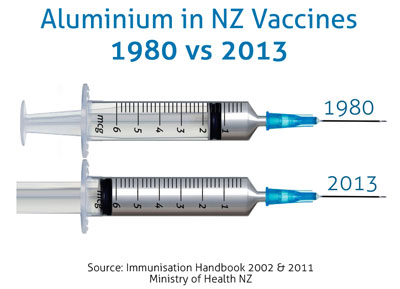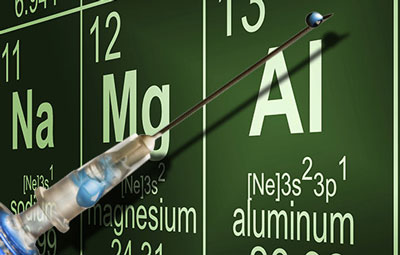Aluminum and vaccines: what the research reveals
According to the CDC’s own statistics, more than 10 million vaccines are given every year to infants. Not so well publicized, however, is the fact that aluminum – a known neurotoxin − is routinely used as an additive in many common vaccines to increase their long-term effects.
In fact, children today receive a staggering 17 shots that contain aluminum – a huge increase over the four they would have received in the 1970’s and mid 1980’s.

Experts sound the alarm about the dangers of neurotoxic aluminum in vaccines
Aluminum is the third most abundant element of the Earth’s crust. But, the mining and processing of aluminum ores, as well as the widespread production of aluminum products are causing a wide variety of health issues – never seen in human history.
According to Dr. Exley, we are now living in the “aluminum age”, with this unwanted element found in a dizzying variety of foods, drugs and cosmetics − including baking powder, antacids, sunscreen, deodorant and baby formula, to name just a few. Yet, there is absolutely no (good) reason for aluminum to be put inside the human body.
Even more disturbing than the presence of aluminum in common products, however, may be its use in vaccines. Due to the ever-increasing vaccination schedule promoted by government health agencies, aluminum is being injected directly into our children on a daily basis – in such common vaccines asDTap (diphtheria, tetanus and pertussis) and the anti-Hepatitis B vaccine, which is routinely given to newborns.
Aluminum is being linked to autism and Alzheimer’s disease
It would be a double tragedy if aluminum – which threatens the health of our children, when injected into infants – is also shown to cause neurological impairments in our senior years, but this is the picture that is beginning to emerge.
The brain is a “target for aluminum”, Dr. Exley warns that a lifetime’s accumulation of aluminum in the brain can finally reach a “toxic threshold” – and set the stage for neurodegenerative and autoimmune diseases. Dr. Exley reports that aluminum toxicity can cause Alzheimer’s disease to develop earlier in life, as well as causing a more aggressive and rapid progression.
In fact, injected aluminum – in animal studies – has been shown to cause behavioral changes and cognitive deficits, including increased anxiety, reduced attention to tasks, increased aggression, and memory loss – mimicking a phenomenon that some scientists and psychologists say is being seen more and more frequently in modern human behavior. We’re talking about the kind of damage to motor neurons in the brain and nervous system that can trigger Lou Gehrig’s disease, Parkinson’s and Alzheimer’s disease.
Christopher Exley, PhD, a biologist and professor of bioinorganic chemistry in the Aluminum and Silicon Research Group of Birchall Centre at Keele University, received his Ph.D. on the ecotoxicology of aluminum from the University of Stirling, and is one of the world’s leading authorities on aluminum exposure and toxicity. His articles have been published in dozens of peer-reviewed publications, including Frontiers in Neurology, The Lancet, and the Journal of Inorganic Biochemistry. He is also the editor of Aluminum and Alzheimer’s Disease: The Science that Describes the Link.
Vaccine ingredient warning: Aluminum phosphate increases toxicity of mercury
Therefore the CDC severely underestimates caution about mercury intolerance
Mercury is the most toxic non-radioactive element on earth, and one scientific fact that most Americans do not know is that aluminum, listed as aluminum phosphate and aluminum hydroxide in vaccines, greatly increases the toxicity of mercury (listed as thimerosal). Why is this so alarming?
We already know that thimerosal (about 50% mercury) is suspected as a cause of autism and the recent massive spikes in cases over the past couple decades. So now, we can realize that the caution about “minimum mercury tolerance” doled out by the CDC is actually severely underestimated, though this warning is not provided on vaccine inserts, which hardly a living soul reads anyway. Now, consider this: there are 25 mcg in one average flu vaccine, and the EPA safety limit is 5 micrograms, so do the math.
Children who are vaccinated simultaneously with multiple vaccines receive over 10 times the safety limit of mercury in one day. Think about that for a second. The safety limits are completely and utterly blown out. This brings us to the conclusion that the present systemic risk in any influenza or infectious disease inoculation has never been evaluated, and therefore, no vaccines can be considered safe or effective.

Thimerosal-containing vaccines (TCVs) are not limited to flu shots
Mercury is toxic to humans, at any level or dose. To even pretend for one minute that injecting this neurotoxin into muscle tissue can be of any benefit is to play into the hands of the ruthless and highly experimental vaccine industry, that has been using this immunization “preservative” for nearly a century.
Using aluminum phosphate in vaccines catapults the toxicity of thimerosal, sending the central nervous system of infants and children into panic mode. Vaccine pushers and propagandists say that the more intense the immune response (at vaccination), the stronger the immunity that is built by antibodies for the long term.
This is a huge lie built on a false hypothesis that’s already been proven wrong. In contrast, the hyper-immune response to being injected with neurotoxins causes many humans to go into anaphylactic shock, comas, and even death. Long term nervous system disorders are becoming more and more commonplace as the vaccine schedule includes more and more vaccines closer together in time.
American children today receive as many as 65 immunizations before age seven. Go figure. Now, thousands of people have immune-deficiencies and severe allergic reactions to certain drugs (and foods) thanks to being overloaded with toxic jabs filled with neurotoxins that are catapulted with aluminum phosphate and aluminum hydroxide.
Did you know that in many developed countries, the use of TCVs is restricted to children at least six months old? In America, the CDC added the influenza vaccine (flu shot) to the vaccine schedule, so it is recommended to pregnant women and infants. The flu shot was revealed by Mike Adams and CWC labs to contain 25,000 times more mercury than is allowed in drinking water.
Now add in some aluminum phosphate and inject it into your muscle tissue, then call it “safe and effective”. Why does the CDC still use mercury? It’s cheap. Period. However, that cost contention, between single-dose and multi-dose vials, has been challenged time and time again.
Neurotoxic chemical doses increased exponentially for infants and done purposely by the CDC
It gets worse. In the last 30 years, the number of pediatric thimerosal-containing vaccines has increased as well as the aluminum–mercury ratio (Al:Hg), rising from 10-fold to 50-fold in certain vaccines today.
Consider hepatitis B vaccines (HBV). Add to that mayhem the scientific fact that children are more susceptible than adults to the toxic effects of heavy metal exposure, and the research that reveals fetuses are even more vulnerable. Autism is a big money maker for the vaccine and pharmaceutical industries nationwide.
Twenty years ago, only one in 10,000 children in America had autism, and now it’s one in every 68. Holistic doctors estimate that, if the toxic jab trend continues along with forced vaccination nationwide, then one in every three children will be diagnosed with some form of autism spectrum disorder (ASD) by the year 2050.
Bottom line: proper function of the brain depends directly upon the integrity of the whole central nervous system, and any injections of mercury and formaldehyde into muscle tissue can have life-long consequences, including a shortened life-span. Of course, the abominable CDC and the insidious vaccine industry have performed no studies of Al toxicity following immunizations with Al-adjuvanted vaccines.
Aluminum salts are obviously catapulting the problems of injecting the “preservative” and “microbial” reducing thimerosal into children, babies, and pregnant mothers, but as long as Big Pharma keeps paying off politicians and our regulatory agencies to look the other way, the chronic damage will continue.
Want natural immunity for you and your children? Look into colloidal silver, organic garlic, vitamin C and D, licorice root, and of course oil of oregano.
Aluminum in vaccines causes damage to the brain and nervous system

Did you know that many childhood vaccines contain potentially toxic, brain-damaging levels of aluminum?
Aluminum is included in vaccines as an “adjuvant”, a component that boosts the body’s short-term immune response in order to produce antibodies to the vaccine agent faster. This very function may be part of what makes aluminum in vaccines dangerous.
Aluminum is also a neurotoxin that has been linked to various types of brain damage.
How aluminum destroys the brain
Numerous human and animal studies have linked aluminum to brain damage, including Alzheimer’s disease. For example, one study found that mice injected with aluminum developed behavioral changes and problems with cognitive and motor function. Autopsies later showed that the motor neurons in their brains and nervous systems showed changes associated with Alzheimer’s disease, Parkinson’s disease and ALS (Lou Gehrig’s disease).
Another study, published by researchers from the University of British Columbia in 2013, found that the risk of autism diagnoses in children was directly correlated with how many aluminum-containing vaccines they had received.
Researchers have speculated that many of aluminum’s neurotoxic effects might be due to its immune-stimulating properties. They have speculated that this property might trigger autoimmune reactions in certain people.
In fact, immune adjuvants have been linked with a variety of immune-mediated diseases, including some for which there is still no name. Conditions linked with exposure to immune adjuvants include siliconosis, Gulf War Syndrome, macrophagic myofasciitis syndrome and some post-vaccination phenomena. Notably, all four diseases share certain signs and symptoms with each other. This observation led a group of researchers from Israel’s Zabludowicz Center for Autoimmune Diseases to propose a new syndrome in 2011, called Autoimmune (Auto-inflammatory) Syndrome Induced by Adjuvants (ASIA).
In a study published in Immunologic Research in 2013, researchers reviewed the evidence linking aluminum adjuvants to neurotoxic effects. They found that aluminum has been linked to both Alzheimer’s disease-like symptoms and to the disease itself in adults, as well as to a disease sharing characteristics of Alzheimer’s, Parkinson’s and ALS. It has also been linked with Gulf War Syndrome. The researchers suggested that aluminum should be considered a potential trigger of ASIA.
Babies get 10 times the adult dose at birth
So why are our kids being injected with aluminum, and how much are they getting?
First, it’s important to understand that while aluminum occurs naturally in the environment, the body reacts to injected aluminum differently than it reacts to aluminum ingested in food. That’s because when the body ingests aluminum, it works to flush it out as quickly as possible to prevent levels in the blood from rising.
The FDA states that for patients being fed intravenous (IV) fluids exclusively, the IV fluids must not contain more than 25 mcg of aluminum per liter (a liter is roughly equivalent to an adult dose). It also notes that as little as 10 mcg of IV aluminum can cause kidney failure in premature infants or those with kidney problems.
So how much aluminum is in the hepatitis B vaccine, which the Centers for Disease Control and Prevention (CDC) recommend giving to babies on the day they are born? A shocking 250 mcg – 10 times the maximum adult dose!
The CDC further recommends that at the age of 2 months, children be given a round of vaccines that collectively contain between 295 mcg and 1,225 mcg of aluminum, depending on the particular combination of shots used.
By age 18 months, a child following the CDC vaccination schedule may have been injected with as much as 4,925 mcg of aluminum.
Is it any wonder that people have questioned the necessity of strictly following the CDC’s vaccination schedule?
Aluminium Adjuvants Have Never Been Approved for Use in Vaccination

Within the first year of life, the CDC recommends that children receive a total of 29 vaccinations, many of which contain the adjuvant aluminum, a substance used in vaccinations to increase the immune response to the antigen (the component of the vaccine that stimulates the immune system to make antibodies).
According to Professor Christopher Exley’s recent research, there are currently two main aluminum adjuvants commonly used in vaccinations today. These are AlHydrogel, a semi-crystalline (boehmite) form of aluminium oxyhydroxide and AdjuPhos, an amorphous salt of aluminium hydroxyphosphate. The sulphate salt of the latter is also listed as being one component of an adjuvant system used in vaccinations against HPV. AlHydrogel and AdjuPhos are commonly referred to as clinically-approved aluminum adjuvants, and yet this is not the case.
There are no aluminum adjuvants that have been approved for intramuscular or subcutaneous injection into humans. There are no requirements for their approval; they are only “approved” as part of vaccine preparations.
His words are extremely worrying, especially when you consider just how many vaccinations on the childhood vaccination schedule contain the adjuvant aluminum as an ingredient.
In a press release, describing Professor Exley’s latest paper, the founder of the Dwoskin Family Foundation, Mrs. Claire Dwoskin wrote:
“Research at Keele University led by Professor Christopher Exley aims to understand the toxicity of aluminum adjuvants in vaccinations and their latest findings are now published in Nature’s Scientific Reports.
In a project funded by the Medical Research Council (MRC) and the Dwoskin Foundation the group at Keele investigated the relationship between the physicochemical properties of aluminum adjuvants and the immune response. Specifically, they show that the reaction of the aluminum adjuvant at the injection site will determine its subsequent fate and therefore its activity both at the injection site and away from the injection site.
One form of aluminum adjuvant which is most commonly used in vaccines is an aluminum hydroxyphosphate salt and is more toxic at the injection site than the second form of aluminum adjuvant, also commonly used in vaccines, aluminum oxyhydroxide salt. However, the latter is more easily loaded into immune reactive cells with the possibility to be transported throughout the body. It is suggested by the Keele research that this loading of aluminum into viable cells offers a mechanism whereby significant amounts of aluminum, a known neurotoxin, might be translocated throughout the body and even across the blood brain barrier and into the central nervous system.”
Countless Childhood Vaccinations Contain Aluminum
According to the CDC’s Vaccine Excipient & Media Summary – Excipients Included in U.S. Vaccines by Vaccine , many of the childhood vaccinations used today include an aluminum adjuvant. However, there are two six-in-one vaccinations that are not listed by the CDC that contain an aluminium adjuvant that have been extremely problematic from the beginning. These are the InfanrixHexa and Hexavac vaccines.
Authors of Some Vaccine Studies State One Thing but Mean Another
In 2011, Giuseppe Traversa and his team wrote a study titled Sudden unexpected deaths and vaccinations during the first two years of life in Italy: a case series study, which, at the time, was considered to be a success.
Studying the incidence of sudden infant death after hexavalent vaccinations in Germany and Italy, the team concluded that their findings were globally reassuring. However, after reading the study in depth, it appears that the team’s outcome was anything but reassuring.
In their abstract, the team stated:
“The signal of an association between vaccination in the second year of life with a hexavalent vaccine and sudden unexpected deaths (SUD) in the two days following vaccination was reported in Germany in 2003. A study to establish whether the immunization with hexavalent vaccines increased the short term risk of SUD in infants was conducted in Italy.”
In their introduction, they stated:
“Most deaths occurring during the first two years of life are attributable to defined causes, mainly represented by congenital malformations, malignancies, and accidents. The events in otherwise apparently healthy subjects, without any evident cause for the death, are classified as SIDS (Sudden Infant Death Syndrome) during the first year of life and SUD (Sudden Unexpected Deaths) at older ages.
In 2003 the suspicion of a possible association between the immunization with a hexavalent vaccine (Hexavac) and the occurrence of SUD was raised in Germany. The signal was based on the observation of three deaths occurring between November 2000 and June 2003 in toddlers in their second year of life within 48 hours following the administration of the
fourth dose
. No signal was detected for vaccinations administered during the first year of life.
Two hexavalent products were licensed in the European Union through a centralized licensure procedure in the year 2000: Hexavac (by Aventis Pasteur MSD) and Infanrix Hexa (by Glaxo SmithKline Biologicals). These combined vaccines contained antigens to immunize against diphtheria, tetanus, pertussis, poliomyelitis, hepatitis B and haemophilus influenzae type b. Since licensure the two vaccines were extensively used in some EU countries (e.g. Germany, Italy, Austria).”

They continued:
“Italy represented the second largest market of Hexavac in the world and no signal of a possible association with the occurrence of SUD emerged from the Italian pharmacovigilance reporting system. Childhood vaccination schedules differed slightly between Germany and Italy as four administrations were recommended in Germany (at the 2nd, 3rd, 4th, and between the 11th and 15th months of life) and three in Italy (at the 3rd, 5th, and 11th-12th months of life). Despite these differences, it was deemed necessary to carry out further investigations and a study protocol was agreed with the CHMP-EMA (Committee for Medicinal Products for Human Use – European Medicines Agency). The study was carried out on the entire Italian population of newborns over a five year period (1999–2003) and a report was presented in 2005 at the CHMP-EMA.”
Describing the vaccination policies in Italy, the team stated that:
“The Italian infant immunization schedule includes three doses of vaccines against diphtheria, tetanus, pertussis, poliomyelitis, hepatitis B and haemophilus influenzae type b, to be administered in the first year of life (at the 3rd, 5th, and 11th-12th months of age); the first MMR vaccination is recommended between the 12th and 15th months. During the six-year study period, combined vaccines have largely replaced the use of single antigens concomitantly administered. Hexavalent vaccines reached 96% of the doses administered in the first year of life in 2004.”
Already, a subtle difference can be established between the two study groups. In Germany, infants were vaccinated with the hexavalent vaccination four times in the first two years of life, whereas, in Italy, infants were only vaccinated three times in their first year of life.
Now this is where the research gets interesting.
The concern that was raised in Germany centered on the fact that three toddlers had died within 48 hours after receiving their fourth dose of the vaccine, which was given in their second year.
Despite this being the case, however, the team decided to conduct their study in Italy and stated:
“Since the largest use of hexavalent products was reached in 2004 we subsequently decided, with the intent to increase the power of the study, to extend the observation period and to include all infants immunized in 2004. As for the preliminary study, the main aim was to assess whether immunization with hexavalent vaccines in the first two years of life was associated with higher short term risk of unexplained death in the Italian setting. We are now reporting the final findings of the study for the entire period 1999–2004.”
They concluded that:
“In conclusion, our findings do not confirm the signal raised in Germany of a 23 fold increase in the risk of SUD in association with the administration of a hexavalent vaccine. Differently from the German signal, where the increased risk concerned the forth dose (infants in the second year of life), in our study only the first dose, which is administered when the incidence of SUD is greater, appears to carry a smaller, though statistically significant, increase in the risk of SUD. The residual uncontrolled confounding effect of age may partly explain this finding. Given the extremely low mortality rate for SUD in Italy, the power of the study was too limited to rule out a small increase in the risk of death in association with any specific vaccine either during the second year of life or following the third vaccine dose. At present, even though many studies investigated the potential association between vaccinations and the occurrence of SUD, only limited evidence is relevant to the role of hexavalent vaccines. Further studies conducted on similar populations may contribute additional evidence and allow a meta-analysis to obtain more precise estimates.”
There were two major problems with this study.
Germany gave their infants four doses of the vaccine while Italy gave them only three.
There were two different hexavalent vaccinations licensed in Europe in the year 2000; however, there was no data provided by the team to identify which vaccination was being used at the time of vaccination.
It appears that there are many who are concerned with this study. Pooja Anthwal, Sonalika Mehta and Jacob Puliyel, from St. Stephens Hospital in Delhi, India, also noted their concern in a comment.
2012 Confidential Papers Leaked Reported 36 Deaths

In 2012, a confidential GlaxoSmithKline document titled Confidential To Regulatory Authorities – Biological Clinical Safety and Pharmacovgilance (GlaxoSmithKline Research and Development, Avenue Fleming 20, 1300 Wavre, Belgium) was leaked to the press, exposing that within a two-year period, a total of 36 infants had died after they had received the 6-in-1 vaccine, Infanrix Hexa.
According to the website Initiative Citoyenne, which reported the news, the 1271-page document revealed that GlaxoSmithKline had received a total of 1,742 reports of adverse reactions between October 23, 2009, and October 22, 2011, including 503 serious adverse reactions and 36 deaths. Initiative Citoyenne stated:
“It’s not that 14 deaths were recorded by GSK between October 2009 and end in October 2011 as we had originally calculated but 36 (14 from 2010 to 2011 and 22 from 2009 to 2010). In addition to these 36 deaths at least 37 other deaths (sudden death mainly), bringing the total to at least 73 deaths since the launch of the vaccine in 2000, and again, this concerns only the death by sudden death, no further recovery of under-reporting.”
Using the figure of 36 deaths over a two-year period, this averages 1.5 deaths per month, which by anyone’s standard is extremely high. Note that only one to ten percent of adverse reactions to vaccines are actually reported. Therefore, in reality, the problem could potentially be far more serious and the actual number of fatalities much higher.
A Deadly Chemical Cocktail
The charts show that many of the babies who died passed away within the first few days of receiving the vaccine. A total of three infants were reported to have died within hours of receiving the vaccine.
This tragedy is hardly surprising, given the vaccine’s ingredients listed on the GSK Infanrix Hexa product information leaflet, which parents are rarely given the chance to read prior to vaccinations. Ingredients include non-infectious substances from tetanus, diphtheria bacteria, purified proteins of pertussis bacteria, the surface protein of the hepatitis B virus (HBsAg, derived from genetically engineered yeast cells) and inactivated poliovirus.
Each 0.5mL dose contains:
– diphtheria toxoid;
– tetanus toxoid;
– pertussis toxoid;
– filamentous haemagglutinin;
– pertactin;
– recombinant HBsAg protein;
– poliovirus Type 1;
– poliovirus Type 2;
– poliovirus Type 3;
– purified capsular polysaccharide of Hib covalently bound to tetanus toxoid;
– aluminium hydroxide;
– aluminium phosphate;
– 2-phenoxyethanol;
– lactose;
– Medium 199;
– neomycin;
– polymyxin;
– polysorbate 80;
– polysorbate 20;
– sodium chloride;
– water.
This product information leaflet proves that not only does Infranrix Hexa contain aluminum hydroxide but it also contains aluminum phosphate, which together are potentially lethal.

GlaxoSmithKline Listed the 1,742 Adverse Reactions in Detail
Interestingly, not only did the leaked GlaxoSmithKline document reveal that 36 infants had died after receiving the Infanrix Hexa vaccination, but they also listed each and every one of the 1,742 adverse reactions in detail. In fact, the list was so long, it required a full twenty pages.
Here, it is listed just a few of the adverse reactions recorded between pages 11 and 31 of their document:
– 106 cases of cyanosis;
– 69 cases of loss of consciousness;
– 165 cases of hypotonia;
– 102 cases of hypotonic-hyporesponsive episodes;
– 107 cases of convulsions;
– 20 cases of epilepsy;
– 98 cases of febrile convulsions;
– 33 cases of grand mal convulsions;
– 47 apnea attacks;
– 108 cases of vomiting;
– 43 cases of Gaze Palsy;
– 12 cases of anemia;
– 1 case of bone marrow failure;
– 6 cases of cardiac arrests;
– 53 cases of diarrhea;
– 593 cases of pyrexia (high temperature);
– 22 cases of gait disturbance;
– 6 cases of anaphylaxis;
– 62 cases of pertussis (whooping cough);
– 2 cases of meningitis pneumococcal;
– 3 cases of arthritis;
– 16 cases of muscle twitching;
– 22 cases of tremors;
– 264 cases of crying (does not indicate the severity);
– 2 cases of Guillain-Barre syndrome;
– 10 cases of respiratory arrest;
– 7 cases of Kawasaki’s disease.
All of these adverse events occurred after the children received the Infanrix Hexa vaccination, some just hours after being vaccinated. For sure you will agree that these documented facts make extremely uncomfortable reading.
However, if this information is not disturbing enough, the GlaxoSmithKline document also revealed that there was a total of 68 cases of vaccination failure! This proves that, not only did their vaccination cause death, injury and illness to nearly 2,000 children, but that this vaccine failed to give any “protection” at all to at least 68 children.
The document was signed by Safety Scientist Vanessa Corman and Vice President, Lead Biological Clinical Safety and Pharmacovigilance Dr. Felix Arellano, M.D., from GlaxoSmithKline Biologicals.
Conclusion
Over the years, hexavalent vaccinations have been responsible for many deaths and disabilities worldwide, and yet they remain in use today. It is shocking to know that a leading pharmaceutical company such as GlaxoSmithKline has known of the danger of these vaccines for years, and yet they continue to portray them as safe and effective.
This is just one of the many papers that have been hidden over the years. How many more scholarly papers that reveal similar adverse reactions have the pharmaceutical industries and governments hidden in their archives?
yogaesoteric
February 3, 2017
